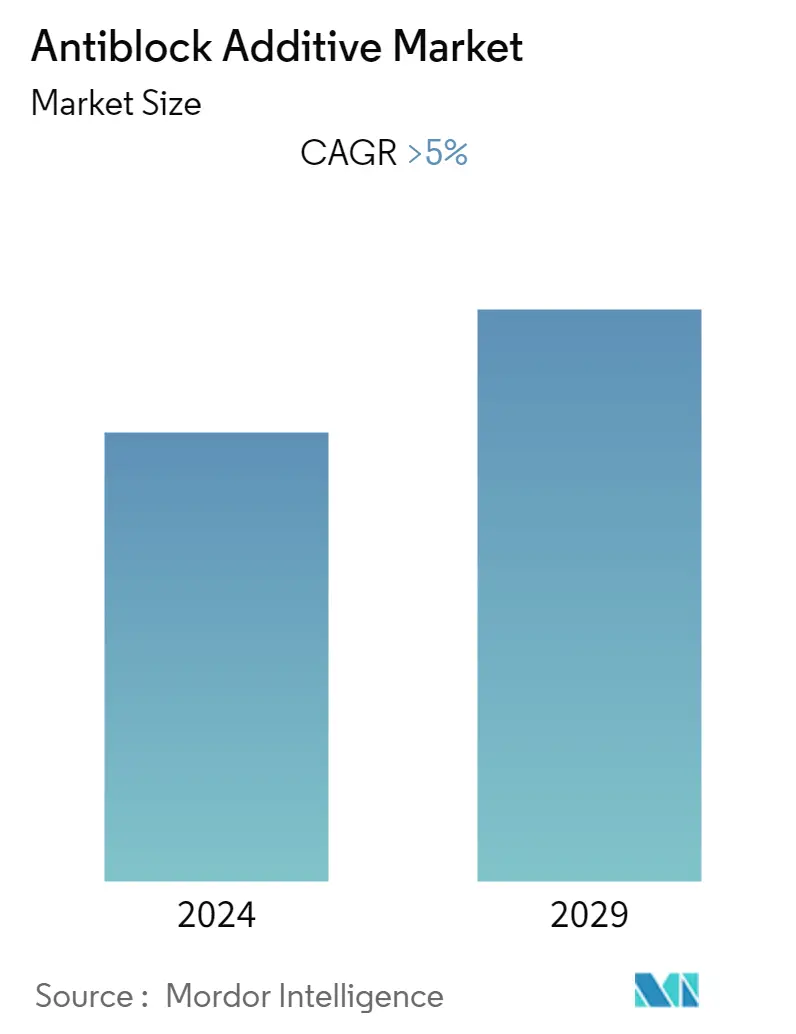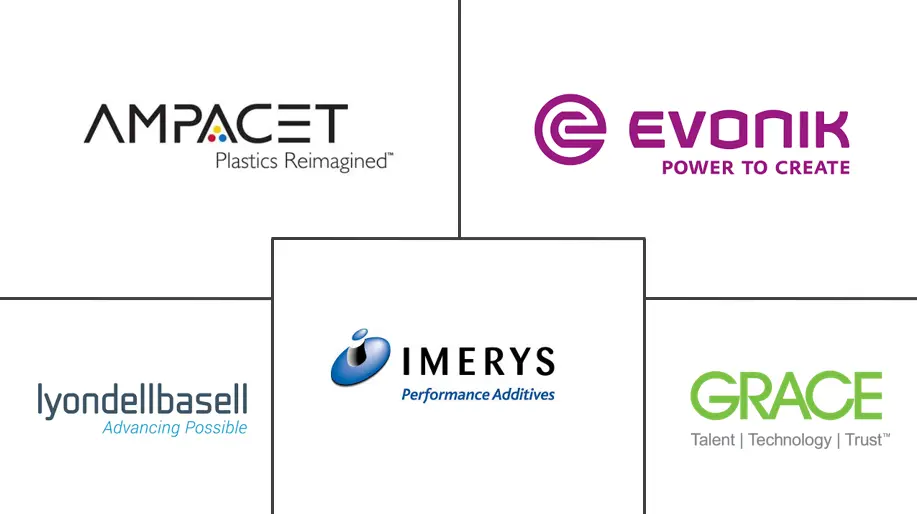Market Size of Antiblock Additive Industry

| Study Period | 2019 - 2029 |
| Base Year For Estimation | 2023 |
| CAGR | > 5.00 % |
| Fastest Growing Market | Asia Pacific |
| Largest Market | Asia Pacific |
| Market Concentration | Low |
Major Players
*Disclaimer: Major Players sorted in no particular order |
Anti-block Additives Market Analysis
The market for antiblock additives is expected to register a CAGR of more than 5%, globally, during the forecast period. Antiblock additives are substances that are added to plastic sheets and films to prevent them from sticking to each other. They improve the processing, life cycle, and performance of the films. They are used in making polyolefin films. Furthermore, they tend to decrease the coefficient of friction between films, thus preventing them from adhering to each other. The growing application of antiblock additives in the food packaging and agriculture sector has been driving the market growth.
However, the high dosage levels of antiblock additives is negatively affecting the optical properties of plastic films. This is likely to hinder the growth of the studied market. Moreover, unfavorable conditions arising due to the COVID-19 outbreak are expected to hinder the market's growth.
The growing demand for antiblock additives in the packaging of medicines is likely to provide opportunities for the antiblock additive market over the next five years.
The Asia-Pacific region is expected to dominate the antiblock additive market, owing to the rising demand from the food packaging and agriculture sector in the region.
Anti-block Additives Industry Segmentation
The antiblock additive market report includes:
| Product Type | |
| Organic | |
| Inorganic |
| Polymer Type | |
| Low Density Polyethylene (LDPE) | |
| Linear Low-density Polyethylene (LLDPE) | |
| Polyvinyl Chloride (PVC) | |
| Biaxially-oriented Polypropylene (BOPP) | |
| High-density polyethylene (HDPE) | |
| Others |
| Application | |
| Food Packaging | |
| Pharmaceutical | |
| Industrial | |
| Agriculture | |
| Others |
| Geography | |||||||
| |||||||
| |||||||
| |||||||
| |||||||
|
Antiblock Additive Market Size Summary
The antiblock additives market is poised for significant growth, driven by their increasing application in food packaging and agriculture. These additives are crucial in enhancing the processing and performance of polyolefin films by reducing friction and preventing adhesion. The demand for antiblock additives is particularly strong in the food packaging sector, where they contribute to improved shelf-life and contamination prevention, aligning with the rising consumer preference for ready-to-eat packaged foods. Additionally, government initiatives aimed at boosting crop output are expected to further stimulate the demand for food packaging, thereby enhancing the market for antiblock additives. The Asia-Pacific region, with its burgeoning food packaging and agriculture industries, is anticipated to lead the market, with countries like China, India, and Vietnam experiencing robust growth.
Despite the positive outlook, the market faces challenges such as the potential negative impact of high dosage levels on the optical properties of plastic films and the lingering effects of the COVID-19 pandemic. However, opportunities are emerging in the pharmaceutical packaging sector, which could offset some of these challenges. The inorganic antiblock additive segment is expected to grow due to its cost-effectiveness and availability. The agriculture sector's increasing reliance on greenhouse films, known for their UV and thermal resistance, is also likely to drive demand for antiblock additives. The market remains fragmented, with key players like Imerys Performance Additives, Ampacet Corporation, and Evonik Industries AG playing significant roles. Overall, the market is set to expand, supported by trends in food packaging and agriculture, particularly in the Asia-Pacific region.
Antiblock Additive Market Size - Table of Contents
-
1. MARKET DYNAMICS
-
1.1 Drivers
-
1.1.1 Growing Food Packaging Sector
-
1.1.2 Rising Demand for Greenhouse Protected Cultivation
-
-
1.2 Restraints
-
1.2.1 Negative Affect on the Optical Properties of Plastic Film
-
1.2.2 Unfavorable Conditions Arising Due to COVID-19 Outbreak
-
-
1.3 Industry Value Chain Analysis
-
1.4 Porter's Five Forces Analysis
-
1.4.1 Bargaining Power of Suppliers
-
1.4.2 Bargaining Power of Buyers
-
1.4.3 Threat of New Entrants
-
1.4.4 Threat of Substitute Products
-
1.4.5 Degree of Competition
-
-
-
2. MARKET SEGMENTATION
-
2.1 Product Type
-
2.1.1 Organic
-
2.1.2 Inorganic
-
-
2.2 Polymer Type
-
2.2.1 Low Density Polyethylene (LDPE)
-
2.2.2 Linear Low-density Polyethylene (LLDPE)
-
2.2.3 Polyvinyl Chloride (PVC)
-
2.2.4 Biaxially-oriented Polypropylene (BOPP)
-
2.2.5 High-density polyethylene (HDPE)
-
2.2.6 Others
-
-
2.3 Application
-
2.3.1 Food Packaging
-
2.3.2 Pharmaceutical
-
2.3.3 Industrial
-
2.3.4 Agriculture
-
2.3.5 Others
-
-
2.4 Geography
-
2.4.1 Asia-Pacific
-
2.4.1.1 China
-
2.4.1.2 India
-
2.4.1.3 Japan
-
2.4.1.4 South Korea
-
2.4.1.5 Rest of Asia-Pacific
-
-
2.4.2 North America
-
2.4.2.1 United States
-
2.4.2.2 Canada
-
2.4.2.3 Mexico
-
-
2.4.3 Europe
-
2.4.3.1 Germany
-
2.4.3.2 United Kingdom
-
2.4.3.3 France
-
2.4.3.4 Italy
-
2.4.3.5 Rest of Europe
-
-
2.4.4 South America
-
2.4.4.1 Brazil
-
2.4.4.2 Argentina
-
2.4.4.3 Rest of South America
-
-
2.4.5 Middle-East and Africa
-
2.4.5.1 Saudi Arabia
-
2.4.5.2 South Africa
-
2.4.5.3 Rest of Middle-East and Africa
-
-
-
Antiblock Additive Market Size FAQs
What is the current Antiblock Additive Market size?
The Antiblock Additive Market is projected to register a CAGR of greater than 5% during the forecast period (2024-2029)
Who are the key players in Antiblock Additive Market?
Imerys Performance Additives, Ampacet Corporation , W. R. Grace & Co.-Conn., A. Schulman, Inc. (LyondellBasell) and Evonik are the major companies operating in the Antiblock Additive Market.

